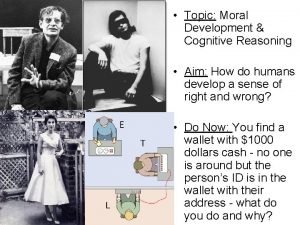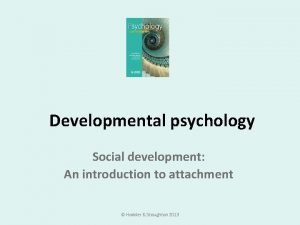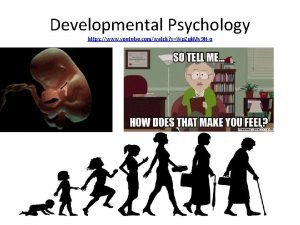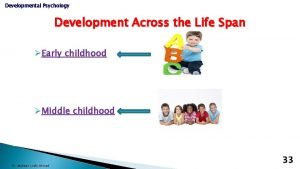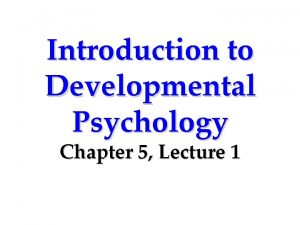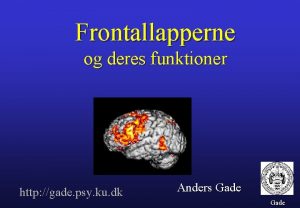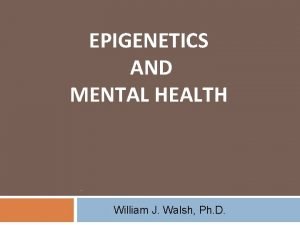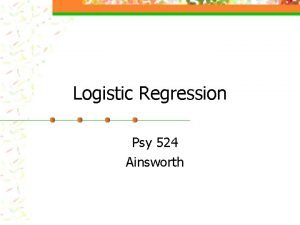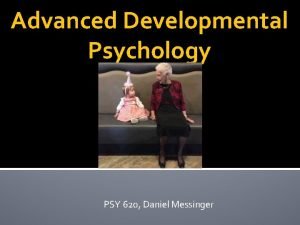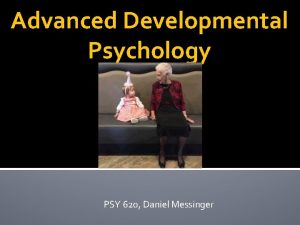Advanced Developmental Psychology PSY 620 P AdulthoodParenting overview



















































- Slides: 51

Advanced Developmental Psychology PSY 620 P

Adulthood/Parenting (overview) �Emerging adulthood �Transition to parenthood �Parenthood and happiness �Pregnancy leads to long-lasting changes in human brain structure Hoekzma et al. Gabe. �Coparenting in Lesbian, Gay, & Heterosexual Couples : Adopted Children's Outcomes Farr & Patterson. Katie �Biology of parenting �Oxytocin, neuroimaging, and fathers

Development defined recap: Individual change over time that: � Reorganizes Multiple systems (entire person) � Successive, sequential Crawl before you walk � Non-reversible (stable) You can’t go back �Normative Everyone’s doing it �Continues over lifespan

Schwartz, S. J. (in press). Turning point for a turning point: Advancing emerging adulthood theory and research. Emerging Adulthood. Download

Postponing the adult role…?

Emerging Adulthood The age period from the late teens through at least the mid-20 s (approximately age 18 – 25) Previously “young adulthood, ” “transition to adulthood” Erikson conceptualized “young adulthood” as lasting from the late teens to age 40! More appropriate when most people were married and in a stable job by the early 20 s—no longer the case in industrialized societies. �Arnett (2007) E. Prince

Emerging Adults are now… �Getting married later �Changing jobs frequently �Pursuing postsecondary/graduate education �Having sex before marriage �Living together before marriage �But, they are still… Accepting responsibility for oneself Making independent decisions Becoming financially dependent (eventually)

% married by 15 & 18 Societal variability

Is parenting a developmental transition? For females? For males?

The Effect of the Transition to Parenthood on Relationship Quality: An 8 -Year Prospective Study (Doss et al. , 2009) Parents and nonparents generally show similar amounts of decline in overall relationship functioning over the first 8 years of marriage but these changes tend to occur suddenly following the birth of the baby for parents and more gradually over time for nonparents. Rubenstein

Parents: dotted = fathers, solid = mothers Nonparents: dotted = males, solid = females Parents Rubenstein Change Patterns Nonparents dotted = males, solid = females

Danzi

Study 1: Parents happier overall… � Parents reported higher levels of life satisfaction, happiness, and meaning in life than nonparents Large, nationally representative World Values Survey (n = 6, 906; ages 17 – 96), single-items � Having more children was correlated with life satisfaction and meaning in life (but not happiness) Danzi

Parents reported more happiness, positive emotion, meaning in life, & fewer depressive symptoms Experiencesampling, 329 adults (ages 18 – 94), paged 5 times daily over 7 days to rated 9 emotions on 7 point scale � Study 3. Parents reported more positive emotions and more meaning when taking care of children than when not Parent’s gender, age, race, and SES did not moderate relationship for any variables Danzi

Is pregnancy/birth a developmental transition? Cognitive trade-offs of Pregnancy Brain • Pregnant women may have declines in specific aspects of cognition, but cognitive advantages in other areas. • Reallocation of cognitive resources to social safety? Anderson, M. V. , & Rutherford, M. D. (2012). Evolutionary Psychology. Crawley, R. , Grant, S. , & Hinshaw, K. I. M. (2008). Applied cognitive psychology. Christensen, H. , Poyser, C. , Pollitt, P. , & Cubis, J. (1999). Journal of reproductive and infant psychology. Maylott

Pregnancy leads to longlasting changes in human brain structure S. Gabe Hatch, S. G.

Pregnancy is common � Most women undergo pregnancy once in their lives � Little is known about how this process affects the brain � Animal studies indicate that changes happen physiologically as well as in the endocrine system � Followed by a flood of estrogens that typically exceeds the estrogen exposure of a woman’s entire nonpregnant life � Other endocrine events involving less extreme fluctuates in hormone levels are known to render structural and functional alterations in the brain (e. g. , puberty) � Even small hormonal changes have resulted to neural alterations Hatch, S. G.

We do know something about the brain during pregnancy � Women � 1909 – Enlargements of the pituitary gland was first observed in deceased pregnant women (2 x as large) �The ventricles and outer border of the brain have been contoured �Increases in ventricular size and decreases in brain size during late pregnancy � Men �Despite the review on brain changes for women, the introduction is completely lacking on any physiological changes among men Hatch, S. G.

Study Goals � These authors performed a prospective neuroimaging study (before versus after pregnancy) involving first-time mothers (and fathers) and compared this group to women that have never given birth (or fathers without children) � Five ways: �These authors wanted to see whether pregnancy is associated with change in the gray matter structure of the human brain �The authors also tested the discriminative power of the gray matter volume changes �Examined the gray matter volume of first-time fathers and control men without children �Investigated a potential link to maternal attachment �Tested the long-term persistence of pregnancy effects with a 2 year post-pregnancy follow-up session Hatch, S. G.

Results Hatch, S. G.

Assessment Structure Brain Scans were Obtained Before Pregnancy (Preconception) If Successful, Brain Scans were Obtained After Completion of Pregnancy Brain Scans were Obtained 2 -Years Post-Pregnancy Hatch, S. G.

Goal 1 – Gray Matter Volume Changes Before and After Pregnancy � Baseline comparisons indicated that there were no pre-existing difference in gray matter volume between the two groups � Within/between group, greater gray matter volume reductions were located in the anterior and posterior midline, the bilateral prefrontal cortex, and the bilateral temporal cortex � Within/between group differences were observed in cortical surface area and thickness Null Findings � White matter volume analyses indicated that there were no significant changes in white matter volume across time points � These results did not differ by means of conception � These changes did not result in differences in cognitive performance Hatch, S. G.

Goal 2 – Discriminative Power � Support vector machine � All women could be correctly classified as having been pregnant or not in between these sessions on the basis of gray matter changes in the brain � Changes in the right middle temporal gyrus, inferior frontal gyrus, and posterior cingulate cortex as the regions of greatest predictive power. These factors alone contributed to over 50% of the decision function Hatch, S. G.

Goal 2 – Discriminative Power, continued. � All discriminate analyses involving average surface area and cortical thickness indicated that 84. 4% of women could be correctly classified as having undergone pregnancy or not on the basis of surface area � Nearly 70% could be classified on the basis or cortical thickness change � And 95. 6% of women could be classified using measures of average gray matter volume change Hatch, S. G.

Goals 3 and 4 – Father’s Gray Matter Changes, Maternal Attachment Goal 3: Father’s Gray Matter Changes - Null Finding � No changes in neural gray matter volumes between the two groups Goal 4: Maternal Attachment � Using the three dimensions of the Maternal Postnatal Attachment Scale, gray matter volume changes of pregnancy predicted the quality of mother-to-infant attachment and the absence of hostility towards their newborns in the postpartum period Hatch, S. G.

Goal 4 – Mother Attachment � The strongest neural activity in response to the women’s babies corresponded to the regions that lost gray matter volume across pregnancy Hatch, S. G.

Goal 5 – 2 -year follow up – are these changes maintained? � Animal models suggest that these alterations are evidence even in old age… � All the findings except for the left hippocampal cluster were maintained over the two-year follow-up period Hatch, S. G.

Discussion

Pregnancy Changes the Brain Among Women � Goal 1 Implications (Gray Matter Changes): Pregnant women undergo a symmetrical pattern of gray matter volume reductions across pregnancy � Goal 2 Implications (Classification): Women can be accurately classified (i. e. , pregnant versus not pregnant) based off of this information � Goal 3 Implications (Fathers): First-time fathers saw no difference in gray matter changes compared to men without children � Goal 4 Implications (Attachment): Gray matter reductions appear to be associated with attachment � Goal 5 Implications (Follow up): These results appear to be maintained over time Hatch, S. G.

Consistencies with Other Stages of Life � During adolescence, reductions in gray matter also occur. This is regarded as a fine-tuning of connections into functional networks which corresponds to healthy cognitive, emotional, and social development � Because pregnancy is associated with similar reductions in gray matter volume, and the observed reductions are not randomly distributed but take place in higher order regions associated with social processes, the authors speculate that the female brain undergoes a further maturation or specialization. This could include enhanced emotion and face recognition Hatch, S. G.

Conclusions � Pregnancy is associated with substantial and long-lasting alterations in brain structure. This may serve an adaptive purpose for pending motherhood. Hatch, S. G.

Discussion Questions � There were several null findings throughout this manuscript: white matter volume analyses indicated that there were no significant changes in white matter volume across time points, these results did not differ by means of conception, these changes did not result in differences in cognitive performance, no fluctuations in father’s gray matter. If any, which null finding surprised you the most and why? � The machine learning algorithm applied in this study resulted in stunningly accurate classification of pregnant versus non-pregnant women. What implications could accurate predictions from an f. MRI have on other areas of psychology (e. g. , diagnoses, treatment outcomes, etc. ). � Perhaps one weakness of the current study is its sample size (~ 20 individuals); however, the effects seem to be large (Cohen’s d = 0. 80 -2. 00) and result in accurate classification. � Are concerns about sample size warranted in the psychological/medical sciences if it results in large effects? � Do we think that these results are reproducible? Hatch, S. G.

Socio-cultural changes have led to increased paternal involvement in childrearing, including gay male parents raising children without maternal care It has been suggested that the human father’s brain adapts to the parental role through active involvement in childcare

Parental Neural Networks � Emotional Processing Network Subcortical and paralimbic structures Rapidly detects motivationally salient and survival-related cues, and enables parents to automatically identify and immediately respond to infant distress Phylogenically ancient Associated with vigilance, affective salience, reward and motivation � Bilateral amygdala, ventral anterior cingulate (v. ACC ), left insula and inferior frontal gyrus (IFG), ventral tegmental area (VTA) Mentalizing Network Cortical regions ▪ Bilateral superior temporal gyrus (STG), lateral frontopolar cortex, ventromedial prefrontal cortex (vm. PFC), and temporal poles Involved in social understanding, theory of mind, and cognitive empathy Plays role in parents’ ability to infer mental states from behavior, cognitively represent infant states, predict infant needs, and plan future caregiving Activated in parents’ first weeks of parenting

Neural networks implicated in parenting Cortical: Bilateral superior temporal gyrus (STG), lateral frontopolar cortex, ventromedial prefrontal cortex (vm. PFC), and temporal poles Subcortical and paralimbic structures: Bilateral amygdala, ventral anterior cingulate (v. ACC), left insula and inferior frontal gyrus (IFG), ventral tegmental area (VTA)

Experiment in nature � Participants: 89 first-time parents 41 heterosexual biological parents ▪ 20 Primary Care (PC) Mothers ▪ 21 Secondary Care (SC) Fathers ▪ 48 Primary Care (PC) homosexual fathers ▪ Child through surrogacy � Researchers visited families at home between 4 -8 pm Videotaped each parent interacting with infant Coded for parent-infant synchrony ▪ Parent’s careful adaptation of caregiving behavior to infants’ social signals ▪ Coding Interactive Behavior (CIB) manual Salivary samples collected for oxytocin measurement � Within a week, parents went in for f. MRI scanning in response to watching video of themselves interacting with their infant

Group Differences in Parent-Infant Synchrony: PC>SC

Patterns of Neural Activation Similar with differences Activation of a “parental caregiving” network � Across all parents, regardless of group, f. MRI indicated similar patterns of activation, mapping on to both the emotional processing and mentalizing networks Group differences in ROI activation � “Although activity in most brain areas was comparable across parents, two areas showed group differences” Amygdala STS

• PC-Mothers greater amygdala activation than SC-Fathers • SC-Fathers greater STS activation than PC-Mothers • PC-Fathers high amygdala activation similar to PC-Mothers, with high STS activation similar to SC-Fathers

Regional Associations with Parent. Infant Synchrony and Oxytocin PC-Mothers PC-Fathers SC-Fathers

Results: Functional connectivity in relation to primary caregiving experience • Amygdala and STS were significantly interconnected during Self–Infant interaction, only among PC-Fathers (not PC mothers or SC fathers) • For ALL fathers, time spent in direct childcare correlated with amygdala. STS connectivity during viewing of the Self-Infant interaction

Path model leading from the parents' role in caregiving to parent–infant synchrony as mediated by brain activation and oxytocin levels. *P < 0. 05; **P < 0. 01; ***P < 0. 001.

Conclusions � PC mothers showed greater activation in subcortical emotion processing structures (i. e. , amygdala), while SC fathers showed greater activation in cortical socio-cognitive circuits (i. e. , STS). These differing patterns of activation were each correlated with higher levels of oxytocin and parent-infant synchrony. PC fathers exhibited high amygdala activation (like PC mothers), alongside high STS activation (like SC-fathers). � Only PC fathers demonstrated functional connectivity between amygdala and STS, suggesting recruitment/integration of both the emotional processing and mentalizing networks to enable a full range of parenting behaviors. � Among ALL fathers, time spent in direct childcare was linked with degree of amygdala-STS connectivity, suggesting malleability of fathers’ brains to caregiving activities. � Overall, findings indicate a neural basis of parental care (alloparenting substrate) that can flexibly activate through responsive caregiving via brainhormone-behavior pathways, even among fathers lacking the neurobiological cues associated with pregnancy and childbirth. �

Atzil et al. (2017) Dopamine in the medial amygdala network mediates human bonding

Bonding Network Mother-child Synchrony – Dopamine level in Striatum Atypical maternal behavior – attenuated striatum responses Atypical maternal behavior – disrupted amygdala & PCC Amygdal a

Current Study • • Participants: 19 mother (21 -42 yr) - infant (4 -24 mo) dyads Procedures: • 2 -min interactions at home: coded for mother-infant synchrony • Vocalization, gaze , affect, touch • Scanning: own infant vs. unfamiliar infant play (twice) • PET: Dopamine responses • f. MRI: functional connectivity

Mother–Infant Synchrony Vocalization Synchrony Maternal Attunement

Vocalization Synchrony - Dopamine

Maternal Attunement - Connectivity

Dopamine – Connectivity (own infant)

Main Findings 1. 2. 3. Dopamine is involved in mother-infant bonding positively. NAcc and pallidum serve the regulatory function of dopamine of bonding behavior. Regions work as a network for bonding.
 Unit 9 developmental psychology
Unit 9 developmental psychology Lawrence kohlberg developmental psychology
Lawrence kohlberg developmental psychology Research methods in developmental psychology
Research methods in developmental psychology Wilhelm wundt structuralism
Wilhelm wundt structuralism Attachment theory bowlby
Attachment theory bowlby Developmental psychology
Developmental psychology Devonte is a graduate student in developmental psychology
Devonte is a graduate student in developmental psychology Unit 3 developmental psychology
Unit 3 developmental psychology Psy 3024 ucf
Psy 3024 ucf Sublimimation
Sublimimation Animism examples psychology
Animism examples psychology Chapter 5 developmental psychology
Chapter 5 developmental psychology Euro psy
Euro psy Psy2055
Psy2055 Psy 2055
Psy 2055 Psy2055
Psy2055 Psy
Psy Daniel sanin
Daniel sanin Psy
Psy Psy
Psy Psy
Psy Psy
Psy Psy 226
Psy 226 Suppose twin teenagers are vying
Suppose twin teenagers are vying Psy academy
Psy academy Nukleus caudatus
Nukleus caudatus Psy walsh
Psy walsh Pes charakteristika
Pes charakteristika Túlavé psy vzor
Túlavé psy vzor 11 psy
11 psy Regression psy
Regression psy Psy
Psy Psy 335 purdue
Psy 335 purdue Schedule 1 tdg
Schedule 1 tdg 12vac35-105-520
12vac35-105-520 Toefl 620
Toefl 620 [email protected]
[email protected] Trigo buck 120
Trigo buck 120 Jms 620
Jms 620 Data domain dd160
Data domain dd160 Arinc 620
Arinc 620 Meam 620
Meam 620 Aruba acl 設定
Aruba acl 設定 Was julius caesar a good emperor
Was julius caesar a good emperor Isa 620 using the work of an expert
Isa 620 using the work of an expert Krs 620
Krs 620 Positive psychology ap psychology definition
Positive psychology ap psychology definition Social trap
Social trap Fundamental attribution error ap psychology
Fundamental attribution error ap psychology Introspection methods of psychology
Introspection methods of psychology Social psychology is the scientific study of:
Social psychology is the scientific study of: Health psychology definition ap psychology
Health psychology definition ap psychology

